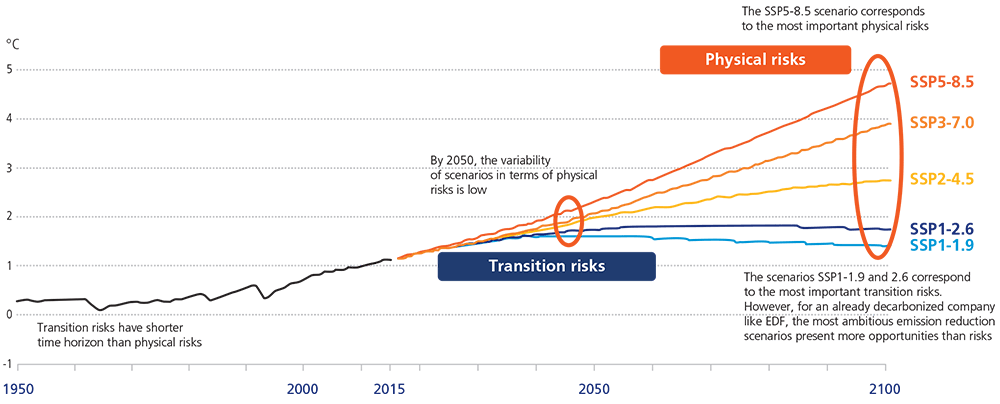3.1.3.2.2.2 Transition risks and opportunities for the EDF group
| Risk category | Description | Potential impact for the EDF group |
|---|---|---|
| Legal risks | Legal risks DescriptionClimate-related litigation |
Legal risks Potential impact for the EDF groupRisk of cancellation of licences, risk of litigation following exceptional climatic events, risk of litigation related to the EDF group publications, particularly as regards the duty of vigilance. |
| Political and regulatory risks | Political and regulatory risks DescriptionTension over uses of water |
Political and regulatory risks Potential impact for the EDF groupRisk involved in the sharing of water resources due to multiple uses and multiple stakeholders in a context of increasing water scarcity. |
| Risk category Tension over access to land and use of soils |
Description Risk involved in the necessary land resources for renewable energy due to regulation (biodiversity, agricultural lands) and the legitimacy of sharing with numerous stakeholders. |
|
| Risk category Political difficulties to achieve the objectives of the Paris Agreement |
Description Opportunity: as a low-carbon leader*, the EDF group is called on to play a key role in decarbonisation of the European economy. |
|
| Customer – market risks | Customer – market risks DescriptionChange in customer expectations |
Customer – market risks Potential impact for the EDF groupOpportunity: increased demands of own consumption, energy efficiency, electric mobility, green deals and low carbon. |
| Risk category Change in uses of electricity |
Description Opportunity: decarbonised electricity is recognised as an indispensable means to decarbonise the economy. |
|
| Technological risks | Technological risks DescriptionStability and security of electricity networks |
Technological risks Potential impact for the EDF groupRisk/Opportunity: risk of instability to the system in case of a high penetration rate of renewable energies; key role of nuclear energy usable together with renewable energies to ensure stability of the network. |
| Risk category Transition technologies |
Description Risk/Opportunity: potential emergence of technologies such as CCSU, thermal solar, small modular reactors, storage or in the area of negative emissions. |
|
| Financial risks | Financial risks DescriptionAccess to competitive financing |
Financial risks Potential impact for the EDF groupRisk/Opportunity: risk of non-alignment of investors with the 1.5°C criteria. Opportunity to provide the EDF group with sustainable financing (Green Bonds, positive incentive loans). |
| Risk category Stranded assets |
Description Risk of stranded thermal assets after regulatory changes or carbon price increases. |
* See section 3.1.1 “Group carbon trajectory”.
3.1.3.2.3 Climate risk and opportunity scenario analysis
3.1.3.2.3.1 Physical risk scenarios
To quantitatively assess the physical risks of climate change (chronic and acute), the EDF group uses scenarios developed by the IPCC. This refers mainly to RCP (Representative Concentration Pathways) scenarios from the fifth evaluation report, which are progressively being updated using SSP-RCP (Shared Socioeconomic Pathways – Representative Concentration Pathway) scenarios from the sixth evaluation report. These scenarios are based on values of radiative forcing due to combined greenhouse gas emissions and aerosols by 2100, as well as changes in land use: the higher the radiative forcing, the more energy enters the earth-atmosphere system, which warms and changes as a result. Only the most ambitious scenarios for greenhouse gas emission reductions (SSP1-2.6 and SSP1-1.9) give a better than 50% probability of limiting the rise in global mean temperatures by the end of the century to less than 2°C and 1.5°C (respectively) more than during the pre-industrial era. The trending scenario (SSP5-8.5) shows a more than 50% likelihood of an increase in excess of 4°C by 2100 compared to the pre-industrial era.

This graph shows the climate risk and opportunity scenario analysis.
Transition risks have shorter time horizon than physical risks
1950: approximately 0.2⁰C
2000: approximately 0.8⁰C
2015: approximately 1.1⁰C
By 2050, the variability of scenarios in terms of physical risks is low
SSP5-8.5: approximately 2.1⁰C
SSP3-7.0: approximately 1.9⁰C
SSP2-4.5: approximately 1.8⁰C
SSP1-2.6: approximately 1.7⁰C
SSP1-1.9: approximately 1.5⁰C
2100 :
SSP5-8.5: approximately 4.7⁰C
SSP3-7.0: approximately 3.9⁰C
SSP2-4.5: approximately 2.8⁰C
SSP1-2.6: approximately 1.7⁰C
SSP1-1.9: approximately 1.5⁰C
